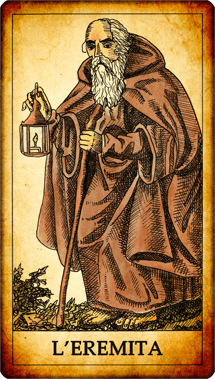
The Hermit is the wise old man who bases the future on the knowledge of the past, walking with slow, cautious steps and leaning on the seven-knotted bamboo cane. His right hand holds up a lantern which illuminates his path, but which he himself partially veils with a hem of his cloak so as not to hurt his weak eyes, unaccustomed to the light.
His great gift is modesty, the awareness that one's knowledge, compared to the entity of science, is still nothing.
Thus, renouncing proud intellectual ambitions, he humbly confined himself to gathering the essential notions for his journey on this earth. He wears a brown robe externally and blue internally similar to the cloak of Apollonius of Tyana, endowed with insulating properties, symbol of air and earth. The Hermit flees the contact of others, lives in communion with the ideal, operating secretly in the occult, with a work of slow, invisible gestation. He is connected to Yesod, the foundation, the condensed potentiality of the seed, the demiurge, lord of virtuality.
He indicates prudence, wisdom, detachment from the material world, chastity, withdrawal, celibacy; a secret revealed; an initiative that will have a slow but positive outcome, a pure, selfless love, a right goal. He symbolizes alternative medicines, politics, archeology, extrasensory phenomena, a sense of duty, patience, serenity, reflection, frugality; solid things, cemeteries, prisons, old houses, ruins. The Hermit represents an ascetic, a doctor, a herbalist, a guide, a faithful friend, a psychiatrist, a scientist; but also his father, his elders, his ancestors. He binds to winter, to Saturday, to the month of December, to the planets Saturn and Neptune, to the zodiac signs Virgo and Capricorn.
In the negative: this blade presages delayed or canceled achievements, obstacles, poverty, excess of fear, obstinacy in celibacy, coldness in love, widowhood, isolation, loneliness, abandonment; pessimism, sadness, wrong advice; misplaced trust, lack of sincerity, stubbornness, dangers. Prudence becomes mistrust and generates stasis, regression, fear of reality and reluctance to express one's feelings. Indicates doom, misfortune, death (next to other negative cards). Badly paid work, unpleasant professions. It also symbolizes a person who denies his help or who tries / even to harm; a pessimistic, cold and self-righteous routine. On the physical level it announces rheumatism, stones, hearing, dental, skin disorders, falls, fractures, chronic diseases.
The advice of the arcane
Be wary of hasty actions. Take time and reflect.
Pairings
- Flanked by the Popess: nasty secrets.
- Close to the Pope: introspection, study, research.
- Next to the Lovers: love betrayal.
- Accompanied by the Force: energy to aim at a goal.
- Followed by the Force and the Devil - a powerful and insidious old man.
- At the overturned Hanged Man - betrayal of a relative.
- Near Death and the Ace of Cups - death of a loved one.
- Followed by Death and the 10 of Swords: death of the consultant.
- At the Tower: danger, imprisonment for slander, errors of assessment, distrust of one's potential.
- Followed by the Stars: success achieved after a long wait.
- Accompanied by the Moon: hidden enemies.
- Followed by the Moon and the Hanged Man: shipwreck.
- Near the Sun - an exposed impostor, harmony, wisdom.
- Joined to the Judgment: unfair judgment.
- Next to a arcanum of Cups: amorous disappointment, delayed wedding; a relationship without momentum.
- Accompanied by an arcane of Wands: long effort, laborious research.
- Flanked by a blade of Pentacles - financial loss, blocked investments.
- Combined with a blade of Swords: Cowardice.



